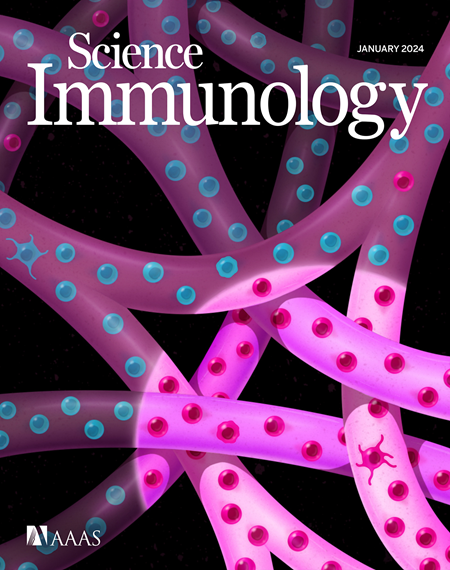Eosinophil innate immune memory after bacterial skin infection promotes allergic lung inflammation
IF 17.6
1区 医学
Q1 IMMUNOLOGY
引用次数: 0
Abstract
Microbial exposure at barrier interfaces drives development and balance of the immune system, but the consequences of local infections for systemic immunity and secondary inflammation are unclear. Here, we show that skin exposure to the bacterium Staphylococcus aureus persistently shapes the immune system of mice with specific impact on progenitor and mature bone marrow neutrophil and eosinophil populations. The infection-imposed changes in eosinophils were long-lasting and associated with functional as well as imprinted epigenetic and metabolic changes. Bacterial exposure enhanced cutaneous allergic sensitization and resulted in exacerbated allergen-induced lung inflammation. Functional bone marrow eosinophil reprogramming and pulmonary allergen responses were driven by the alarmin interleukin-33 and the complement cleavage fragment C5a. Our study highlights the systemic impact of skin inflammation and reveals mechanisms of eosinophil innate immune memory and organ cross-talk that modulate systemic responses to allergens.
细菌性皮肤感染后嗜酸性粒细胞先天免疫记忆促进过敏性肺部炎症
屏障界面处的微生物暴露可促进免疫系统的发育和平衡,但局部感染对全身免疫和继发性炎症的影响尚不清楚。在这里,我们表明皮肤暴露于金黄色葡萄球菌持续塑造小鼠的免疫系统,对祖细胞和成熟骨髓中性粒细胞和嗜酸性粒细胞群体产生特异性影响。感染引起的嗜酸性粒细胞变化是持久的,与功能以及印记表观遗传和代谢变化有关。细菌暴露增强了皮肤过敏致敏,并导致过敏原诱导的肺部炎症加剧。功能性骨髓嗜酸性粒细胞重编程和肺过敏原反应是由白细胞介素-33和补体切割片段C5a驱动的。我们的研究强调了皮肤炎症的全身影响,揭示了嗜酸性粒细胞先天免疫记忆和器官串扰调节对过敏原的全身反应的机制。
本文章由计算机程序翻译,如有差异,请以英文原文为准。
求助全文
约1分钟内获得全文
求助全文
来源期刊

Science Immunology
Immunology and Microbiology-Immunology
CiteScore
32.90
自引率
2.00%
发文量
183
期刊介绍:
Science Immunology is a peer-reviewed journal that publishes original research articles in the field of immunology. The journal encourages the submission of research findings from all areas of immunology, including studies on innate and adaptive immunity, immune cell development and differentiation, immunogenomics, systems immunology, structural immunology, antigen presentation, immunometabolism, and mucosal immunology. Additionally, the journal covers research on immune contributions to health and disease, such as host defense, inflammation, cancer immunology, autoimmunity, allergy, transplantation, and immunodeficiency. Science Immunology maintains the same high-quality standard as other journals in the Science family and aims to facilitate understanding of the immune system by showcasing innovative advances in immunology research from all organisms and model systems, including humans.
 求助内容:
求助内容: 应助结果提醒方式:
应助结果提醒方式:


